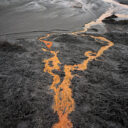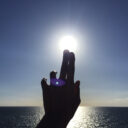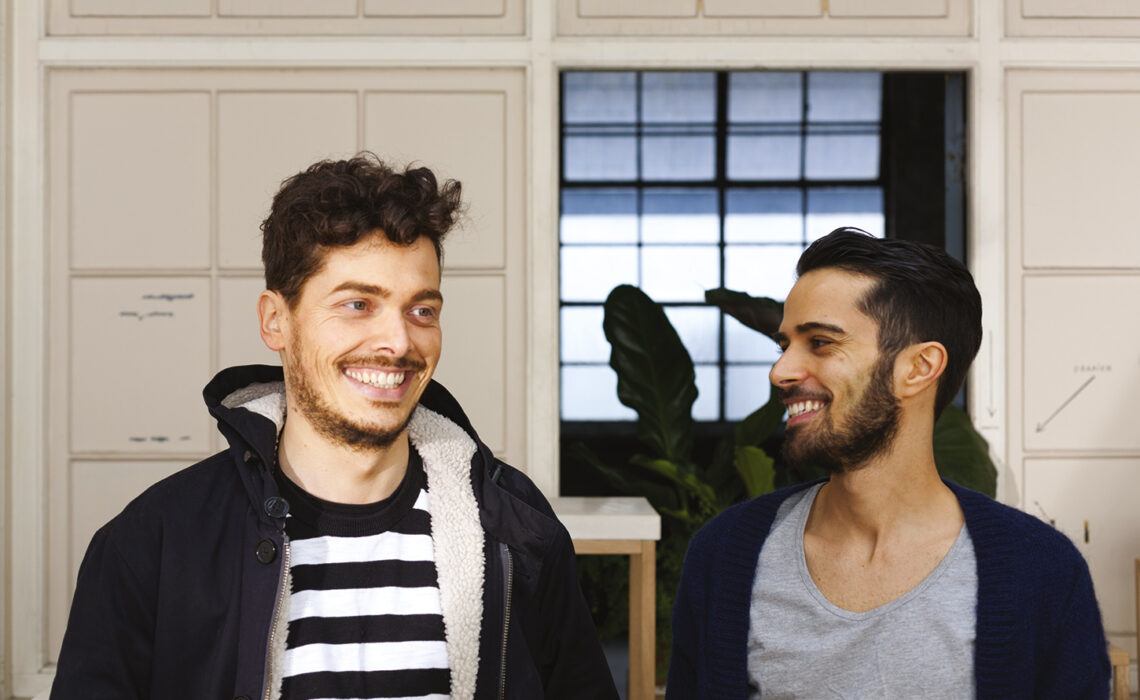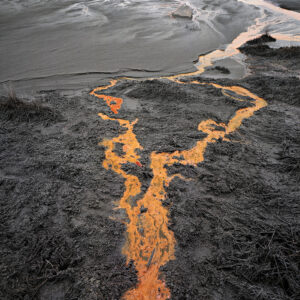Nati all’estremo sud e all’estremo nord dell’Italia e oggi felicemente lanciati nell’iperuranio del design internazionale, Andrea Trimarchi, classe 1983 e Simone Farresin, classe 1980, sono i fondatori di Studio Formafantasma, con sede ad Amsterdam, Paesi Bassi.
La passione per il prodotto nasce nel corso di Master IM presso la Design Academy di Eindhoven, dove si diplomano nel 2009. Da quel momento, Formafantasma sviluppa un ciclo di progetti caratterizzato da sperimentazioni sui materiali esplorando il rapporto tra tradizione e cultura locale, con particolare attenzione alle tematiche della sostenibilità etica ed ambientale, come per il progetto Ore Streams, sul recupero dei prodotti elettronici: “Questo è per noi industrial design, perché non ha a che fare con il disegnare nuovi prodotti, ma è un prendersi cura delle conseguenze della produzione di massa”.
Lo Studio ha lavorato fin dall’inizio come ponte tra artigianato, industria, oggetto e cliente finale, con particolare interesse alla ricerca continua verso il settore del design inteso nel suo significato più ampio. Il desiderio di analizzare le discipline più diverse, dall’arredo all’arte, dai materiali innovativi alla moda, fino all’illuminotecnica, ha permesso loro di avere molteplici commissioni da partner tra loro diversi come Fendi, Hermès, Droog, Galleria Giustini/Stagetti, Roma, Gallery Libby Sellers, Established and Sons, Lexus, Krizia International e Flos. Risulta di particolare interesse il progetto per Sportmax, il marchio del gruppo Max Mara, con il quale si è progettato uno spazio effimero per una brevissima sfilata di moda.
Se è vero che la ricerca continua sui materiali e l’innovazione dei processi industriali apre loro le porte dell’industrial design e della moda, la riflessione critica e concettuale non gli preclude quelle dei musei e delle gallerie più illustri.
I luoghi in cui le loro opere sono state presentate sono molteplici e molto prestigiosi sia in Italia che all’estero come il Metropolitan Museum ed il MoMa di New York, il Victoria and Albert di Londra, lo Stedelijk Museum di Amsterdam, il Chicago Art Institute, il Centre Georges Pompidou di Parigi, il Museo Textiel a Tilburg, lo Stedelijk Museum ’s-Hertogenbosch, MUDAC Lausanne, Mint Museum of Craft and Design in North Carolina, MAK Museum a Vienna, Fondation Cartier a Parigi, Centraal Museum a Utrecht, Les Arts Décoratifs e CNAP a Parigi, che hanno disegni di Formafantasma nelle loro collezioni permanenti.
Interessante è anche il contributo teorico e critico di Andrea e Simone con conferenze e seminari in varie università e istituzioni, come il nuovo Master GEO-DESIGN presso la Design Academy di Eindhoven o il corso di laurea in Design presso il programma MADE di Siracusa, in Italia, creando una congiunzione costante tra i due Paesi, quello di nascita e quello adottivo, di grandissimo rilievo.
Il fil rouge che unisce i diversi progetti è l’analisi innovativa ed alternativa sui materiali, lavorando meticolosamente al processo per ciascuno dei progetti, che sviluppano sempre in coppia. Analizzando infatti la poliedrica e numerosissima mole di lavori e mostre prodotte instancabilmente in questi anni, il loro approccio al design non sembra concedere nessuna deviazione dal paradigma analisi-materiali-ricerca-critica-tradizione. Ciò che conta è la riflessione che scaturisce dall’oggetto stesso. Emblematico è il loro primo lavoro che si riferiva alle teste di moro siciliane ma completamente decostruite nella forma e nel significato diventando una riflessione sull’immigrazione.
Molto interessanti sono i lavori svolti in alcune gallerie del sud Italia come il progetto Botanica commissionato dal Plart di Napoli, una fondazione italiana dedicata alla ricerca scientifica e all’innovazione tecnologica nel recupero, restauro e conservazione di opere d’arte e design prodotte in plastica. Marco Petroni, curatore del progetto, ha incaricato lo Studio di creare la propria interpretazione personale dei materiali polimerici. In Botanica le plastiche sono utilizzate in modo inusuale, nel tentativo di suggerire una nuova estetica post industriale agli oggetti creati da Formafantasma. “Se ad oggi possiamo dire di essere in corsa verso un’era post-petrolio, il periodo pre-petrolio sembra essere nuovamente riscoperto alla ricerca di alternative sostenibili. Il lavoro di Formafantasma guarda al passato come fonte di ispirazione per offrire all’utente un punto di vista alternativo sull’idea di plastica, reinterpretando materiali e tecniche perdute” (Marco Petroni). Lo Studio Formafantasma ha studiato il periodo pre-bachelite, scoprendo trame, sensazioni e possibilità tecniche inaspettate offerte dai polimeri naturali estratti da piante o derivati animali. In questo modo si sono sperimentati materiali come Colofonia, Damar, Copale, uno stato sub-fossile di ambra, gomma naturale, gommalacca – un polimero estratto da escrementi di insetti che colonizzano gli alberi – e Bois Durci – un materiale del 19° secolo composto da polvere di legno e sangue animale. Resine vegetali e animali si combinano nei loro prodotti, mentre la tavolozza dei colori si basa su tonalità ambrate naturali in combinazione con materiali tradizionali come il legno, ceramica e metallo.
“Con Botanica, Studio Formafantasma offre una nuova prospettiva sulla plasticità, reinterpretando la tecnologia secolare persa sotto la superficie impeccabile della produzione di massa” e rivalutando la fondamentale importanza del materiale nel processo creativo, andata perduta durante l’industrializzazione del design.
Portavoci di una responsabilità etica ed ecologica del design, per Andrea e Simone “non c’è più l’urgenza di produrre come si faceva una volta”, anzi “è criminale, vuol dire sostanzialmente riempire il mondo di ulteriori prodotti”. Il loro obiettivo “non è produrre nuove cose ma cercare di capire come spingere un po’ più in là la riflessione sugli oggetti”. Il design portatore di idee è il cuore della loro filosofia.
Research, critique and tradition
Born in the deep South and the far North of Italy, and today succesfully well-known in the hyperuranion of international design, Andrea Trimarchi, class of 1983, and Simone Farresin, class of 1980, are the founders of Studio Formafantasma, based in Amsterdam, Netherlands.
The passion for the product grows during the Master IM at the Eindhoven Design Academy, where they graduated in 2009. From that moment on, Formafantasma develops a cycle of projects, characterized by experimentations on the materials, exploring the relationship between tradition and local culture, always with a special attention to the topics of ethic and environmental sustainability, as with the Ore Streams project, on the recovery of electronic products: “For us, this is industrial design, because it does not involve designing new products, but instead it involves taking care of the consequences of mass production”.
The Studio has worked, ever since its beginning, as a bridge between craftmanship, industry, object and final client, with a special focus on the continuous research in the design field, in its broadest meaning. The desire to analyze different disciplines, from furniture to art, from the most innovative materials to fashion, up to illuminating engineering, allowed them to receive countless commissions from different partners such as Fendi, Hermès, Droog, Galleria Giustini / Stagetti, Roma, Gallery Libby Sellers, Established and Sons, Lexus, Krizia International and Flos. Particularly interesting is the project for Sportmax, the brand of the Max Mara group, with which they designed an ephemeral space for a brief fashion show.
If it is true that the continuous research on materials and the innovation of the industrial process opened them the doors for industrial design and fashion, the critical and conceptual reflection does bar them the most important museum and galleries.
Their works have been displayed in numerous and very prestigious places, both in Italy and abroad; places such as the Metropolitan Museum and the MoMa in New York, the Victoria and Albert Museum in London, the Stedelijk Museum in Amsterdam, the Chicago Art Institute, The Centre Georges Pompidou in Paris, the Textiel Museum in Tilburg, the Stedelijk Museum ‘s Hertogenbosch, MUDAC Lausanne, Mint Museum of Craft and Design in North Carolina, the MAK Museum in Vienna, the Fondation Cartier in Paris, the Centraal Museum in Utrecht, Les Arts Décoratifs and CNAP in Paris, featuring sketches by Formafantasma in their permanent collections.
Of interest is the continuous theorical critical contribution by Andrea and Simone, with conferences and seminars in various universities and institutions, such as the new GEO-DESIGN Master at the Eindhoven Design Academy, or the degree course in Design with the MADE program in Syracuse, Italy, creating a very important and permanent link between their country of birth and the adoptive country.
The fil rouge connecting the different projects is the innovative and alternative analysis on the materials, meticulously working on this process for each project, that they always develop together. Indeed, analyzing their multifaceted and plentiful collection of works and exhibitions tirelessly produced during these years, their approach on design does not seem to concede any deviation from the analysis-materials-research-critic-tradition paradigm. What matters is the reflection resulting from the object itself.
Emblematic is their first work, referencing the Sicilian Moors heads, that are however completely deconstructed in their shape and meaning, becoming a reflection on immigration.
Particularly interesting are the works for several galleries in South Italy, such as the Botanica project, commissioned by the Plart in Naples, an Italian foundation dedicated to the scientific research and technology innovation in the recovery, restoration and preservation of plastic-made works of art and design. Marco Petroni, project curator, entrusted the Studio with the creation of their worn personal interpretation on multifaceted materials. In Botanica plastics are employed in an unusual way, to suggest the objects created by Formafantasma a new post-industrial aesthetic. “Today, we can say we are moving toward a post-oil age, and the pre-oil period seems to be discovered again in the research for sustainable alternatives. Formafantasma’s work looks at the past a source of inspiration, in order to offer the user an alternative point of view on the use of plastic, reinterpreting lost materials and techniques.” (Marco Petroni). Studio Formafantasma studied the pre-Bakelite period, discovering unexpected patterns, sensations, and technical possibilities, offered by the natural polymers extracted from plants or animal derivatives. This way, they experimented materials such as Rosin, Dammar Gum, Copal, a sub-fossil state of amber, natural gum, shellac – a polymer extracted from the excrements of insects inhabiting trees – and Bois Durci – a XIX century material composed of wood dust and animal blood. Plant and animal resins combine in their products, while the color palette is based on natural amber shades, in combination with traditional materials such as wood, ceramics and metal.
“With Botanica, Studio Formafantasma offers a new perspective on plasticity, reinterpreting the centuries-old technology, lost below the flawless surface of mass production, and re-evaluating the fundamental importance of material in the creative process, forgotten during the industrialization of design”.
Spokesmen for an ethic and ecologic responsibility of design, according to Andrea and Simone “there is no more the urgency of production as there was before”, on the contrary “it is criminal, it basically means filling the world with even more products”. Their goal “is not producing new things but trying to understand how we can push forward the reflection on objects”. A design beared of ideas is the heart of their philosophy.








No Comments